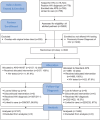Effectiveness of HIV self-testing when offered within assisted partner services in Western Kenya (APS-HIVST Study): a cluster randomized controlled trial
- PMID: 38965976
- PMCID: PMC11224581
- DOI: 10.1002/jia2.26298
Effectiveness of HIV self-testing when offered within assisted partner services in Western Kenya (APS-HIVST Study): a cluster randomized controlled trial
Abstract
Introduction: Assisted partner services (APS) is an effective strategy for increasing HIV testing, new diagnosis, and linkage to care among sexual partners of people living with HIV (PLWH). APS can be resource intensive as it requires community tracing to locate each partner named and offer them testing. There is limited evidence for the effectiveness of offering HIV self-testing (HIVST) as an option for partner testing within APS.
Methods: We conducted a cluster randomized controlled trial comparing provider-delivered HIV testing (Standard APS) versus offering partners the option of provider-delivered testing or HIVST (APS+HIVST) at 24 health facilities in Western Kenya. Facilities were randomized 1:1 and we conducted intent-to-treat analyses using Poisson generalized linear mixed models to estimate intervention impact on HIV testing, new HIV diagnoses, and linkage to care. All models accounted for clustering at the clinic level and new diagnoses and linkage models were adjusted for individual-level age, sex, and income a priori.
Results: From March to December 2021, 755 index clients received APS and named 5054 unique partners. Among these, 1408 partners reporting a prior HIV diagnosis were not eligible for HIV testing and were excluded from analyses. Of the remaining 3646 partners, 96.9% were successfully contacted for APS and tested for HIV: 2111 (97.9%) of 2157 in the APS+HIVST arm and 1422 (95.5%) of 1489 in the Standard APS arm. In the APS+HIVST arm, 84.6% (1785/2111) tested via HIVST and 15.4% (326/2111) received provider-delivered testing. Overall, 16.7% of the 3533 who tested were newly diagnosed with HIV (APS+HIVST = 357/2111 [16.9%]; Standard APS = 232/1422 [16.3%]). Of the 589 partners who were newly diagnosed, 90.7% were linked to care (APS+HIVST = 309/357 [86.6%]; Standard APS = 225/232 [97.0%]). There were no significant differences between the two arms in HIV testing (relative risk [RR]: 1.02, 95% CI: 0.96-1.10), new HIV diagnoses (adjusted RR [aRR]: 1.03, 95% CI: 0.76-1.39) or linkage to care (aRR: 0.88, 95% CI: 0.74-1.06).
Conclusions: There were no differences between APS+HIVST and Standard APS, demonstrating that integrating HIVST into APS continues to be an effective strategy for identifying PLWH by successfully reaching and HIV testing >95% of elicited partners, newly diagnosing with HIV one in six of those tested, >90% of whom were linked to care.
Clinical trial number: NCT04774835.
Keywords: Africa; clinical trials; partner services; point of care; self‐testing; treatment.
© 2024 The Author(s). Journal of the International AIDS Society published by John Wiley & Sons Ltd on behalf of International AIDS Society.
Conflict of interest statement
The authors declare that they have no competing interests.
Figures



References
-
- UNAIDS . Understanding Fast‐Track: accelerating action to end the AIDS epidemic by 2030 [Internet]. 2015. Available from: https://www.unaids.org/sites/default/files/media_asset/201506_JC2743_Und.... Accessed 31 Sep 2021.
-
- Hogben M. Partner notification for sexually transmitted diseases. Clin Infect Dis. 2007;44(Suppl 3):S160–S174. - PubMed
-
- Consolidated guidelines on HIV testing services for a changing epidemic [Internet]. who.int.org; 2019. Available from: https://www.who.int/publications/i/item/consolidated‐guidelines‐on‐hiv‐t.... Accessed 30 Sep 2021.
Publication types
MeSH terms
Associated data
Grants and funding
LinkOut - more resources
Full Text Sources
Medical
Miscellaneous

